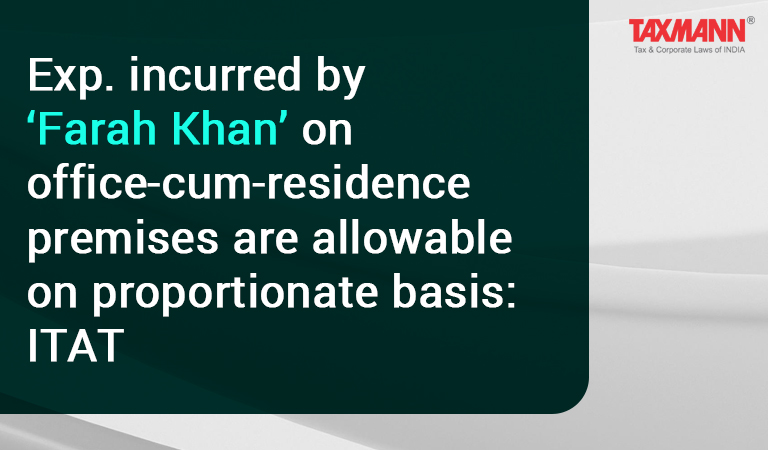Exp. incurred by ‘Farah Khan’ on office-cum-residence premises are allowable on proportionate basis: ITAT
- Blog|News|Income Tax|
- 2 Min Read
- By Taxmann
- |
- Last Updated on 21 August, 2023

Case details: ACIT v. Farah Khan - [2021] 129 taxmann.com 61 (Mumbai - Trib.)
Judiciary and Counsel Details
-
- P.P. Bhatt, President and Manoj Kumar Aggarwal, Accountant Member.
- Chetan Karia for the Appellant.
- Dr. Shanteshwar Swami for the Respondent
Facts of the Case
Assessee–Farah Khan was engaged as a film director as well as a professional choreographer. During assessment proceedings, it transpired that assessee owned 6 flats. All the units were stated to be used as office-cum-residence for assessee. Assessee submitted that a specified part thereof was used by her as an office, and the remaining part was used for residential purposes. She claimed a deduction for expenses incurred on the part which was used as an office.
However, Assessing Officer (AO) concluded that assessee could neither produce documentary evidence nor provide any justification to substantiate her claim that the premises were being used as her office. Accordingly, the deduction claimed by assessee was disallowed.
ITAT held
On appeal, Mumbai ITAT held that assessee was a creative artist. She was engaged as Choreographer and film producer. For said purpose, assessee would require creative space from where she could carry out professional engagements. In this year, except for this space, she had not claimed any other office set-up. Till 2011, assessee had similar units at Embassy Tower which were being used as office-cum-residence, in the same manner. The proportionate expenses relating to office in all the earlier years were allowed to assessee.
To meet expanding professional demands and the need for a bigger house, assessee moved to a new duplex apartment. Said premises were stated to be similarly used by assessee for office-cum-residence purposes. Assessee had 6 units, out of which 2 units were stated to be used for professional purposes. Assessee had claimed proportionate expenses relating to these two units. Moreover, assessee had already produced sufficient documentary evidence in the shape of a copy of the Service Tax Registration Certificate, copies of commercial contracts entered into with producers/ third parties, etc.
All these documents mentioned assessee’s residential address and support the claim of assessee. Assessee had also produced the office’s photographs and an affidavit affirming the facts relating to her office at Oberoi Sky Heights. To overcome the deficiency in the photograph, as stated by AO, a video recording of the office and residence to prove that a clearly demarcated part was used as an office was furnished during the hearing. The same clearly support the case of assessee.
In other words, assessee had proved that she used a clearly demarcated part of the premise as the office, which was duly supported by various documents on record. Thus, there was nothing on record to disprove assessee’s claim.
Disclaimer: The content/information published on the website is only for general information of the user and shall not be construed as legal advice. While the Taxmann has exercised reasonable efforts to ensure the veracity of information/content published, Taxmann shall be under no liability in any manner whatsoever for incorrect information, if any.

Taxmann Publications has a dedicated in-house Research & Editorial Team. This team consists of a team of Chartered Accountants, Company Secretaries, and Lawyers. This team works under the guidance and supervision of editor-in-chief Mr Rakesh Bhargava.
The Research and Editorial Team is responsible for developing reliable and accurate content for the readers. The team follows the six-sigma approach to achieve the benchmark of zero error in its publications and research platforms. The team ensures that the following publication guidelines are thoroughly followed while developing the content:
- The statutory material is obtained only from the authorized and reliable sources
- All the latest developments in the judicial and legislative fields are covered
- Prepare the analytical write-ups on current, controversial, and important issues to help the readers to understand the concept and its implications
- Every content published by Taxmann is complete, accurate and lucid
- All evidence-based statements are supported with proper reference to Section, Circular No., Notification No. or citations
- The golden rules of grammar, style and consistency are thoroughly followed
- Font and size that’s easy to read and remain consistent across all imprint and digital publications are applied




